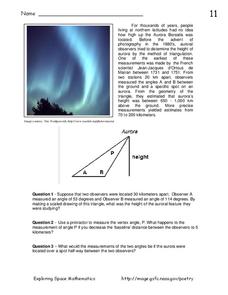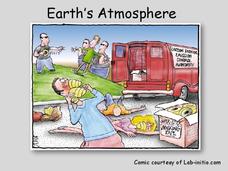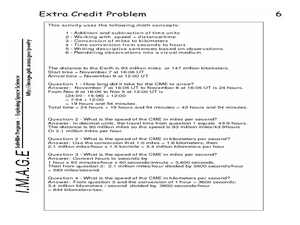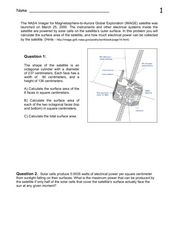PHET
Where to See an Aurora
Where can you see an aurora in North America? After completing an astronomy activity, scholars can locate the exact coordinates. Pupils plot points of the inner and outer ring of the auroral oval and answer questions based on their...
NASA
Auroras
In this auroras learning exercise, students define 11 terms related to space phenomena such as auroras, coronal mass ejections and auroral ovals. Students use a given website to help them define the terms and they write a 500 word essay...
Curated OER
Aurora Borealis
In this Aurora Borealis learning exercise, students read about how early scientists used triangulation to measure the height of the Aurora Borealis. Students solve 3 problems using triangulation.
Curated OER
Auroras
In this auroras instructional activity, students read 2 descriptions written about a massive solar storm that occurred in 1859. Students read each description and compare the specific points in each. They create a time line of the events...
Curated OER
Auroras
In this aurora worksheet, students read a description of an aurora observed by Captain Standard in 1859. Students interpret the description with a drawing giving as much detail as possible using colored media to capture what they read.
Curated OER
Power and Auroras
In this power and auroras worksheet, students read about the relationship between power, work and energy and how the power of auroras are measured by the light they produce. Students use a data chart of the Great Aurora of 2003 to answer...
Curated OER
Coronal Mass Ejection
In this coronal mass ejection learning exercise, students read about the coronal mass ejections detected by the IMAGE satellite and the Hubble Space Telescope resulting in auroras. Students solve 6 problems and determine the speed of the...
Curated OER
Aurora to Magnetosphere Global Exploration
In this magnetosphere global exploration activity, students read about the instrument on board a satellite launched by NASA called the Radio Plasma Imager. This imager detects echoes from plasma clouds. Students calculate the distance to...
Curated OER
Galaxies and Stars Scavenger Hunt
In this space worksheet, students identify and describe what auroras are in the sky and why they are made up of different colors. Then they explain why stars are born and what happens to them as they get older. Students also name which...
PHET
Soda Bottle Magnetometer
Introduce learners to set of complete instructions that describe how to build a magnetometer that works just like the ones professional photographers use to predict auroras. The diagrams are wonderfully descriptive, and the written...
NASA
Solar Storms
In this solar storms worksheet, students use an on line source to read newspaper stories about scientific theories and hypothesis related to space weather phenomena. Students answer 7 questions about past solar storms and compare ideas...
Curated OER
Solar Activity
In this solar activity worksheet, students complete a puzzle given a word bank with matching numbers. The numbers correlate to the answers to basic math problems that use the order of operations. Students use their mathematical answers...
Curated OER
The North and South Magnetic Poles
In this north and south magnetic poles worksheet, students read about the presence of auroras over the earth's magnetic poles as opposed to the geographic poles. Students use 2 photographs taken by the IMAGE FUV and the Polar instruments...
Science Geek
Earth's Atmosphere
Ozone gas absorbs the harmful UV-B rays and helps protect humans. An informative presentation begins with the layers of the earth's atmosphere, the pressure and temperature in each of the layers, the ozone layer, the ozone cycle, and the...
Laboratory for Atmospheric and Space Physics
The Solar Wind Tunnel
The winds of change are blowing in our very own solar system! But what makes some heavenly bodies more affected by solar winds than others? Pupils discover the concept of magnetic forces at work in space in this attractive interactive,...
International Technology Education Association
Tidy Up Those Sloppy Force Fields!
It is just magnetic. This resource presents the concept of Earth's and another planet's magnetic field and how spacecrafts detect them. Learners study a problem using magnetometers and participate in three experiments to come up with a...
Curated OER
Solar Storm Timeline
In this solar storm timeline, students read about a series of events that took place in space beginning with a solar flare. Students gather the information and create a time line of events mentioned. They determine the length of time it...
Curated OER
Magnetic Forces and Kinetic Energy
In this magnetic forces and kinetic energy worksheet, students use the formula that relates the speed of an electron in a plasma cloud to its energy to find the speed of 6 different plasma cloud electrons. They answer 5 questions that...
Curated OER
Magnetic Energy
In this magnetic energy worksheet, students are given the formula to calculate the magnetic energy of an object. They use the formula to solve for the magnetic energy of the Earth, a geotail, the Sun, and a solar prominence given their...
Curated OER
Coronal Mass Ejections
In this coronal mass ejections worksheet, students observe a time line of events that took place during a solar storm. Students use the time line to answer 3 questions about the solar storm and the time it took to reach Earth. Students...
Curated OER
Solar and Auroral Events
In this solar and auroral events activity, students answer 5 questions about a coronal mass ejection that traveled to the Earth. They find the time it took to arrive and they determine the speed of the coronal mass ejection in kilometers...
Curated OER
IMAGE Satellite and Solar Cells
In this IMAGE satellite and solar cells worksheet, students calculate the surface area of the satellite in order to determine how much electrical power can be generated by the solar cells.
Curated OER
Solar Storms-Fractions and Percentages
In this solar storms worksheet, learners find the percentage of X-Flares and Halo CMEs that occurred in solar storms and complete a Venn Diagram comparing the numbers of each.
Curated OER
THEMIS: A Magnetic Case of 'What Came First?'
In this magnetic reconnection worksheet, students solve seven problems using the data and graphs from the THEMIS satellite constellations, which show a series of events triggered by a magnetic reconnection. Students interpret the data in...

























